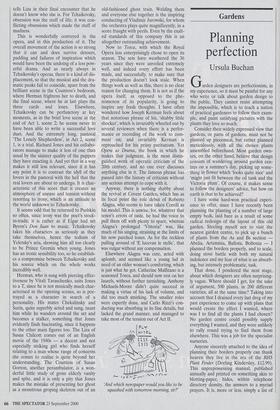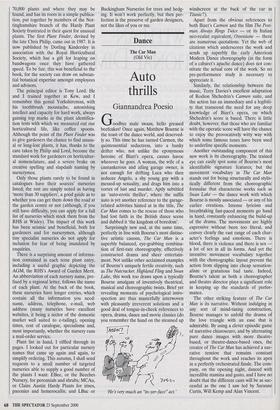Gardens
Planning perfection
Ursula Buchan
Garden designers are perfectionists, in my experience, so it must be painful for any who write or talk about garden design to the public. They cannot resist attempting the impossible, which is to teach a nation of practical gardeners to follow their exam- ple, and paint satisfying pictures with the plants they love so much.
Consider their widely expressed view that gardens, or parts of gardens, must not be planted up piecemeal, but rather planned meticulously, with all the chosen plants assembled beforehand. Most garden own- ers, on the other hand, believe that design consists of wandering around garden cen- tres on a summer's day, picking up some- thing in flower which 'looks quite nice' and `might just fit between the oil tank and the Victoria plum'. Of course, it makes sense to follow the designers' advice, but how on earth is that to be achieved?
I have some hard-won practical experi- ence to offer, since I have recently been planning the planting of a number of large empty beds, laid bare as a result of some radical redesign of the layout of this old garden. Steeling myself not to visit the nearest garden centre, to pick up a bunch of plants from the As and Bs section — Abelia, Artemisia, Ballota, Boltonia — I planned the borders properly, and to scale, doing stout battle with both my natural indolence and my fear of what is an absorb- ing, but intensely problematic, task.
That done, I pondered the next stage, about which designers are often surprising- ly vague. Where should I get, for the sake of argument, 500 plants, in 200 different varieties, all at the same time? Taking into account that I drained every last dreg of my past experience to come up with plans that would create the effect I wanted, where was I to find all the plants I had chosen? No garden centre could possibly supply everything I wanted, and they were unlikely to rally round trying to find them from elsewhere. This was a job for the specialist nurseries.
Anyone sincerely attached to the idea of planning their borders properly can thank heaven they live in the era of the RFIS Plant Finder (Dorling Kindersley, £12.99). This unprepossessing manual, published annually and printed on something akin to blotting-paper, hides, within telephone directory density, the answers to a myriad prayers. It, is, more or less, simply a list of 70,000 plants and where they may be found, and has its roots in a simple publica- tion, put together by members of the Not- tinghamshire branch of the Hardy Plant Society frustrated in their quest for unusual plants. The first Plant Finder, devised by the late Chris Philip, came out in 1987. It is now published by Dorling Kindersley in association with the Royal Horticultural Society, which has a gift for leaping on bandwagons once they have gathered speed. To be fair, this was beneficial to the book, for the society can draw on substan- tial botanical expertise amongst employees and advisors.
The principal editor is Tony Lord. He and I trained together at Kew, and I remember this genial Yorkshireman, with his toothbrush moustache, astonishing intellect and capacity for hard work, always gaining top marks in the plant identifica- tion tests with which we measured out our horticultural life, like coffee spoons. Although the point of the Plant Finder was to give gardeners the chance to find unusu- al or long-lost plants, it has, thanks to the care taken by Philip and Lord, become the standard work for gardeners on horticultur- al nomenclature, and a severe brake on creative spelling and slapdash naming by nurserymen.
Only those plants rarely to be found in catalogues have their sources' nurseries listed; the rest are simply noted as having `more than 30 suppliers', a good guide as to whether you can get them down the road at the garden centre or not (although, if you still have difficulty, you can apply for a full list of nurseries which stock them from the RHS at Wisley). The impact of this work has been seismic and beneficial, both for gardeners and for nurserymen, although tiny specialist nurseries do not apply for inclusion for fear of being inundated by enquiries.
There is a surprising amount of informa- tion contained in each terse plant entry, including a useful graphic depicting the AGM, the RHS's Award of Garden Merit. An abbreviation of each nursery name, pre- fixed by a regional letter, follows the name of each plant. At the back of the book, these nurseries have longer entries, which contain all the information you need: name, address, telephone, e-mail, web address (many nurseries have excellent websites, it being a sector of the domestic market well suited to e-tailing), opening times, cost of catalogue, specialisms and, most importantly, whether the nursery runs a mail-order service.
Plant list in hand, I riffled through its pages. I looked out for particular nursery names that came up again and again, to simplify ordering. This autumn, I shall send requests to a small number of targeted nurseries able to supply a good number of the plants I want: EBee, or the Beeches Nursery, for perennials and shrubs; MCAu, or Claire Austin Hardy Plants for irises, paeonies and hemerocallis; and LBuc or Buckingham Nurseries for trees and hedg- ing. It won't work perfectly, but then per- fection is the preserve of garden designers, not the likes of you or me.























































































 Previous page
Previous page